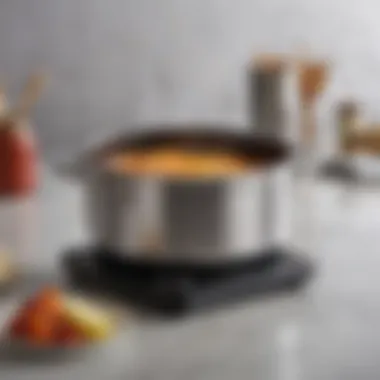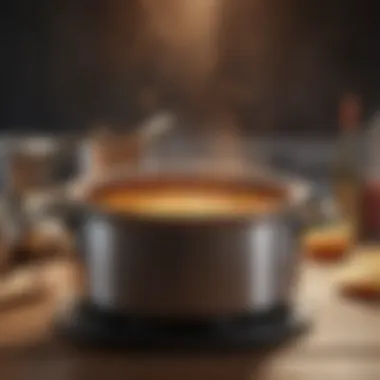Essential Pots for Induction Stove Cooking


Intro
Induction cooking has gained significant popularity in recent years due to its efficiency and precision. Understanding the specific pots that work well with induction stoves is crucial for both culinary enthusiasts and home cooks. The distinctive mechanism of induction cooking relies on magnetic fields to generate heat directly in the cookware, making it essential to select pots made from materials that are compatible with this technology. In this guide, we will explore various aspects of cookware suitable for induction stoves, including the necessary materials, essential features, and maintenance tips.
Why Induction Cooking Matters
Choosing the right pots feels effortless, yet it dramatically impacts cooking performance and efficiency. Induction stoves heat up more quickly and provide better temperature control than traditional stoves. Consequently, using incompatible cookware can lead to disappointing cooking results.
To effectively navigate the selection process for induction-compatible pots, it is useful to examine the unique properties of induction cooking, along with materials and designs that enhance the experience. This guide will inform and empower you to make optimal choices for your kitchen.
Understanding Induction Cooking Technology
Induction cooking represents a significant development in culinary technology. This section explains why understanding this technology is crucial for anyone interested in cooking, especially with induction stoves. The core principle behind induction cooking is electromagnetic energy. Unlike traditional methods, induction cooking heats the cookware directly, making it an efficient and responsive option.
This section will delve into the mechanics of how induction stoves operate and the benefits they offer, including energy efficiency, speed, and enhanced safety features. Additionally, it aims to clarify common misconceptions that might hinder potential users from fully embracing this cooking method.
Understanding the fundamentals of induction cooking can inform consumers’ choices in cookware and improve their overall cooking experience.
How Induction Stoves Work
Induction stoves work through magnetic induction. When a pot made of ferrous material is placed on the induction cooktop, an electric current flows through a coil underneath the ceramic surface. This current generates a magnetic field, which induces an electric current in the pot. The pot itself becomes the heat source, cooking the food quickly and evenly.
This method avoids energy loss commonly seen with gas or electric stovetops. The heating is instantaneous, allowing for precise control over cooking temperatures.
Benefits of Induction Cooking
Induction cooking has several advantages that can enhance the culinary experience.
Energy Efficiency
Energy efficiency is a primary benefit of induction cooking. Since induction stoves convert about 90% of the energy into heat, they waste significantly less energy compared to traditional cooking methods. This efficiency is a notable attraction for environmentally conscious cooks and those looking to manage utility costs. The quick heating times mean less energy is consumed overall, proving induction cooking to be an eco-friendly option.
Speed and Precision
Speed and precision are other significant attributes of induction cooking. The immediate response to temperature adjustments allows for rapid temperature changes. When a user increases or decreases the heat setting, the pot responds almost instantaneously. This control is invaluable when executing recipes that require delicate temperature management, such as melting chocolate or simmering sauces.
Safety Features
Safety features inherent in induction cooking are also noteworthy. The cooktop remains relatively cool, reducing the risk of burns from touching the surface. Additionally, the stove automatically shuts off when no pot is detected, eliminating fire hazards. This makes induction cooking a preferable choice for families and those who prioritize safety in the kitchen.
Common Misconceptions About Induction Cooking
Several common misconceptions surround induction cooking that can deter potential users. A frequent belief is that induction cookware is only available at a high cost; however, options exist across various price ranges. Another misconception is that induction cooking is complex and difficult to master; in fact, many find it to be intuitive. By addressing these misinterpretations, individuals can make a more informed decision about adopting induction cooking into their culinary habits.
Selecting the Right Pots for Induction Stoves
Choosing the right pots for induction stoves is crucial for effective cooking and overall kitchen efficiency. Unlike traditional cooking methods, induction cooking relies on electromagnetic energy to heat pots directly. Therefore, the materials and design of the cookware can significantly impact performance.
When selecting pots, it is essential to consider the material, specific features, and quality of the cookware. Induction stoves require pots that can interact magnetically with their cooking surface. Hence, understanding both ferrous and non-ferrous materials will guide you in making the right choice. Furthermore, key features such as flat bottom designs and magnetic base quality play a role in how uniformly and rapidly heat is distributed across the cooking surface.


Material Requirements for Induction-Compatible Cookware
Ferrous Materials
Ferrous materials, specifically cookware made from iron or steel, are the primary choices for induction stoves. The essential characteristic of ferrous materials is their ability to create a magnetic field, which is necessary for induction cooking to function. This property makes them highly effective and a common choice among users of induction stoves.
The unique feature of ferrous cookware is its durability and heat retention. Cast iron skillets, for instance, can withstand high temperatures and retain heat well, allowing for even cooking. However, a drawback is that they can be heavier and may require more maintenance to prevent rusting.
Non-Ferrous Materials
Non-ferrous materials, including aluminum and copper, have their own benefits but come with specific limitations when it comes to induction cooking. These materials do not inherently possess magnetic properties. However, many manufacturers incorporate a magnetic layer to allow compatibility with induction stoves, which enables users to enjoy the benefits of these materials.
A key characteristic of non-ferrous materials is their excellent heat conductivity. This allows for quick heating and precise temperature control, which appeals to many cooks. However, the main disadvantage is that not all non-ferrous cookware is suitable for induction cooking without modifications, potentially leading to confusion during the purchasing process.
Key Features to Look For
Flat Bottom Design
The flat bottom design is critical for ensuring that pots make full contact with the induction surface. This design allows for even heat distribution, reducing the chances of hot spots during cooking. A pot with a flat bottom can enhance cooking efficiency and improve results.
Another advantage of a flat bottom design is versatility. Such pots can be used on any cooking surface, not just induction, making them a practical addition to any kitchen. However, it is vital to ensure that the pot is perfectly flat to avoid any issues with heat transfer.
Magnetic Base Quality
The quality of the magnetic base is essential for effective induction cooking. A high-quality magnetic base ensures better performance and quicker heating. Pots with a strong magnetic base will heat up faster and maintain that temperature effectively.
Furthermore, relying on good magnetic base quality can extend the longevity of the cookware as it withstands the cyclical heating and cooling. However, lower-quality pots may fail to generate enough heat, leading to poor cooking results and frustration in the kitchen.
Thickness and Heat Conductivity
Thickness and heat conductivity are critical factors when selecting pots. Thicker pots often provide better heat retention and distribution. In contrast, thinner pots may heat up quickly but can lead to uneven cooking.
Choosing pots with good heat conductivity allows for more precise cooking. For example, various materials have different thermal properties, influencing how heat travels through the pot. A good balance of thickness and heat conductivity is essential for optimal cooking performance.
Brands and Options Available
High-End Brands
High-end brands often provide superior quality cookware catering specifically to induction cooking. Brands like All-Clad and Le Creuset are known for their durable materials and excellent heat retention properties. Investing in high-end pots may offer features like ergonomic handles and superior craftsmanship.
The disadvantage, however, lies in the price. High-end options can be a significant investment, which may not fit every cook's budget.
Budget-Friendly Adaptations
Budget-friendly adaptations make induction cooking more accessible. Brands like T-fal and Cuisinart offer cookware designed for induction without breaking the bank. These options often feature basic functionality and materials but can still perform well on induction surfaces.
While these budget-friendly options may lack some advanced features found in high-end brands, they can serve as practical alternatives, especially for those new to induction cooking. It is essential to read reviews and understand specific product features to ensure quality.
Selecting the right cookware can enhance your cooking experience and maximize the benefits of induction technology.
Popular Materials for Induction Cookware


Understanding the right materials for induction cookware is essential for effective cooking. The materials used can significantly impact efficiency, heat distribution, and overall cooking experience. For those using induction stoves, it is important to know that not all cookware will work. Induction cooking relies on electromagnetic fields that require compatible materials.
Stainless Steel
Advantages
Stainless steel pots are widely favored for their durability and resistance to rust and corrosion. Their ability to withstand high temperatures makes them suitable for various cooking methods. One key characteristic is that they can be quite versatile. They often feature a layer of aluminum or copper between layers of stainless steel, promoting even heat distribution. This unique feature allows for precision when cooking, contributing to excellent performance in induction applications.
Disadvantages
Despite their benefits, stainless steel cookware does have some downsides. They can sometimes cause food to stick if not properly preheated or if sufficient oil is not used. This sticking can create an unappealing cooking experience. Additionally, if the base is not magnetic, it will not work on induction stovetops. The quality can vary, creating confusion for consumers who wish to choose the right kind.
Cast Iron
Advantages
Cast iron is renowned for its heat retention and even cooking properties. This material is perfect for slow cooking and is appreciated for its ability to develop a natural non-stick surface over time when properly seasoned. The density of cast iron pots allows them to maintain heat exceptionally well, which is great for many cooking styles. This shows a unique feature that enables reliable cooking outcomes.
Disadvantages
However, there are underlying challenges with cast iron cookware. They tend to be heavy, making them less user-friendly. Also, they require special maintenance, like seasoning to maintain their non-stick quality. Cast iron may react with certain acidic foods, which can alter flavor. These factors can be discouraging for some users seeking easy-to-use cookware.
Copper
Advantages
Copper pots are highly regarded for their exceptional heat conductivity. This characteristic allows for quick heating and temperature adjustments with great precision. Many chefs prefer copper for tasks that require a delicate touch. The aesthetic appeal of polished copper can also elevate the kitchen atmosphere. Its responsiveness to heat changes is the key feature that sets it apart.
Disadvantages
On the flip side, copper cookware does come with some drawbacks. They can be quite high-maintenance as they can tarnish easily and require regular polishing to maintain their appearance. Without a protective lining, copper can react with certain foods, which may be a concern in cooking. These disadvantages make copper a less practical choice for everyday cooks.
Non-Stick Coatings
Non-stick cookware is popular due to its convenience and ease of cleaning. Non-stick coatings allow for less oil usage, making meals healthier and reducing cleanup time. However, these coatings can wear off and may not be suitable for high heat, which can limit their usability. Consumers should be aware of the need for proper care to extend the lifespan of non-stick pots.
In summary, each material has its unique benefits and drawbacks when it comes to induction cooking. Understanding these elements helps in making informed decisions about which pots to use and enhances the overall cooking experience.
Maintenance and Care for Induction Pots
Maintaining and caring for induction pots is crucial for ensuring their longevity and optimal performance in the kitchen. Proper care not only helps to preserve the appearance of your cookware but also enhances its functionality. Induction pots can be a significant investment, so understanding the essentials of maintaining them is important. Taking the right steps can lead to better cooking results as well as a safer kitchen environment.
Cleaning Techniques for Different Materials
Different materials used in cookware require distinct cleaning approaches. For example,
- Stainless Steel: To clean stainless steel pots, use a mixture of warm water and mild dish soap. Avoid bleach or harsh chemicals as they can cause discoloration. For tough stains, a paste of baking soda and water can be effective.
- Cast Iron: Cast iron should be cleaned with hot water and a stiff brush. Avoid soap, as it can strip the seasoning. Immediately dry the pot to prevent rust.
- Copper: For copper pots, use a mixture of lemon juice and salt which naturally brightens the surface. Rinse thoroughly.
- Non-Stick: Use a soft sponge with mild detergent. Avoid metal sponges or abrasive cleaners to maintain the non-stick surface.
Proper cleaning is vital to ensure that the unique properties of each material remain intact and enhance cooking performance.
Preventing Damage and Wear


Avoiding Abrasive Cleaners
Avoiding abrasive cleaners is essential for prolonging the life of your induction pots. Abrasives can scratch the surface, diminishing both appearance and functionality. The key characteristic of this approach is its protective nature. Using non-abrasive cleaning agents maintains the integrity of the pot surfaces. By not using rough sponges or harsh cleansers, you can avoid creating microscopic scratches. This is a beneficial choice, as it can improve the hygiene of your cookware, maintaining a healthy cooking environment.
Proper Storage Techniques
Proper storage techniques contribute significantly to protecting your induction pots from unnecessary wear. Keeping them stacked can lead to scratches if not done carefully. A key characteristic of effective storage is having protective liners or separator pads between pots. This practice is popular because it prevents direct contact and minimizes risks of damage. Storing pots in a dedicated drawer or on a rack can give easy access while ensuring they remain in good shape. Proper storage also helps maintain the performance over time, reducing the need for frequent replacements.
Repairing Minor Damage
Repairing minor damage is an inevitable part of pot ownership. Scratches or minor dents may occur over time, particularly with frequent use. If you find your induction pots looking a bit worse for wear, recognize that not all damage is irreparable.
For small scratches in stainless steel, gentle polishing with a metal polish can restore shine. For cast iron, re-seasoning is crucial when the surface starts to wear. With non-stick cookware, if the coating begins to flake, it may be time to consider replacement, as using damaged non-stick pots can pose health risks.
By taking steps to clean, store, and repair your induction pots, you can ensure they remain an excellent addition to your kitchen. Good maintenance practices create a rewarding cooking experience, making your time spent in the kitchen more enjoyable.
Cooking Techniques and Tips for Induction Stoves
Cooking on induction stoves presents unique challenges and methods that can enhance your cooking experiences. Understanding these techniques allows for better heat control, energy efficiency, and food quality. Induction cooking is not just about having the right pots; it also requires adapting your cooking methods to align with how induction technology works.
Adjusting Cooking Times and Methods
Cooking on induction stoves differs in terms of timing and technique compared to traditional electric or gas cooking. Induction heat is generated directly in the pot, so heating is quicker and often requires adjustments in cooking times. Here are some considerations:
- Faster Heat-Up Times: Because induction hobs heat pots directly, they can reach cooking temperatures almost instantly. Foods that usually require simmering or slow cooking should be monitored closely. Adjust the heat downwards sooner, as it tends to cook faster than expected.
- Experiment with Heat Settings: Most induction stoves provide various heat settings. As you gain experience, assess how different settings impact your cooking. For instance, a setting on medium might become sufficient with some adjustments.
- Adapt to Your Pots: Different pots react uniquely to induction. Thick-bottomed pots generally hold heat better than thin-bottomed ones. This means that the cooking times might vary even if the same food is prepared.
Achieving Optimal Heat Distribution
Even though induction cooking is efficient, achieving even heat distribution is vital for the best results. Here are techniques to consider:
- Use Flat-Bottomed Cookware: It is crucial to use pots with a flat bottom for proper contact with the cooktop. Uneven contacts can lead to hot spots, which can burn food or affect cooking uniformity.
- Ensure Magnetic Base Quality: Not all magnetic bases function the same. Low-quality bases may not distribute heat evenly. Assess your cookware's quality to prevent uneven cooking.
- Stirring Often: Stirring your dishes regularly will help manage heat distribution. Induction can create hot and cold spots in your pot. Regular stirring ensures that all food gets equal heat exposure.
"Induction cooking is recognizing the symbiosis between pot and stove; realize it for perfect meals."
Understanding these techniques and tips when using induction stoves leads to better outcomes in the kitchen. As you adapt to these methods, you will find cooking both faster and more efficient while enhancing the quality of your dishes.
End
One key element that stands out is the necessity of using induction-compatible pots. Induction cooking requires specific materials that can effectively interact with the magnetic field generated by the stove. Failure to do so can lead to inadequate heating and ultimately a frustrating cooking experience. Thus, being aware of the right materials makes all the difference.
The benefits of induction cooking discussed earlier throughout the article are reinforced in this conclusion. They include energy efficiency, speed, and safety. Being reminded of these positive aspects encourages readers to make informed decisions as they equip their kitchens.
Additionally, the guide highlighted maintenance practices that are vital for preserving induction pots. Conducting proper care prolongs the life of these cooking tools. Understanding the relationship between appliance technology and cookware, especially focusing on safe handling and storage, proves to be significant.
In summary, the conclusion wraps up the guide by emphasizing that the right pots and proper care practices must be integral to anyone's cooking regimen. As cooking evolves, having a solid understanding of induction cookware will lead to a more efficient and enjoyable culinary experience.
Recap of Key Points
- Induction-Compatible Materials: Not all pots work with induction stoves. Only ferrous materials like cast iron and specific types of stainless steel are suitable.
- Essential Features: Key attributes such as flat bottoms, strong magnetic bases, and thickness are crucial to ensure optimal performance.
- Maintenance Matters: Proper cleaning and storage techniques can significantly extend the lifespan of induction pots, ensuring they perform well over time.
- Common Misconceptions: Dispel myths regarding induction cooking to foster better understanding and acceptance among users.
Final Thoughts on Induction Pots
In light of the discussions presented, it's clear that selecting the right pots for induction stoves is an exercise in blending technology with practical cooking needs. They are more than mere utensils; they influence cooking efficacy and food quality.
When considering a purchase, focus on trusted brands known for quality induction cookware. High-end options may offer premium materials and construction, while budget-friendly alternatives can still deliver satisfactory results. Understanding both options is crucial for making decisions that align with your cooking habits and budget.
Ultimately, educating yourself about pots for induction stoves equips you to optimize your cooking practices. Embracing these insights allows you to navigate the culinary landscape with confidence and skill.







